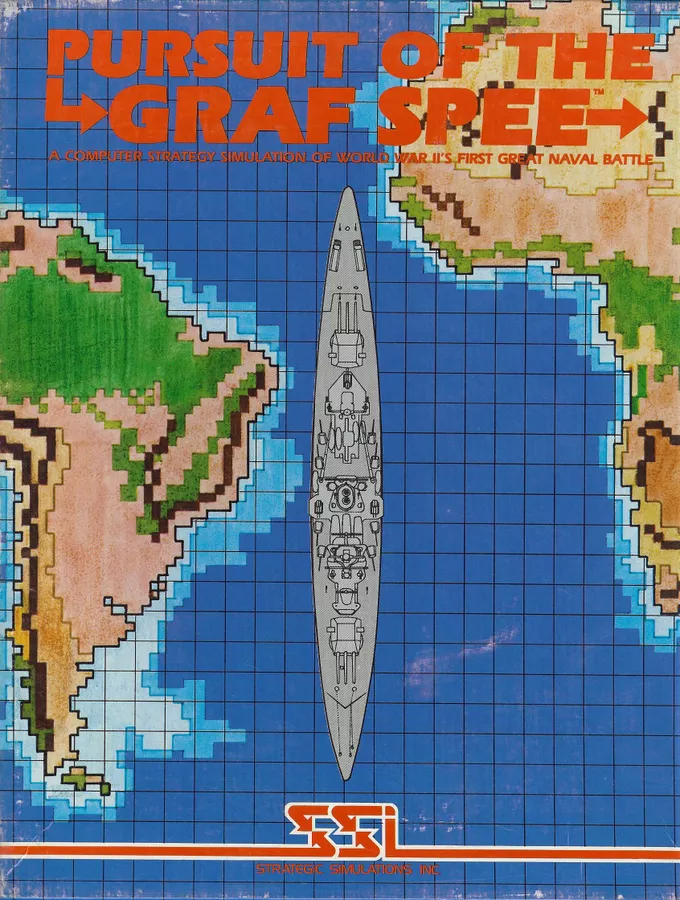
Lieutenant Narwhal ! Are you crazy ? Stop the engines ! It is the night already!
But… why ?
Because at night, our engines run on Victory Points !
The Graf Spee was a “pocket battleship”, a ship that combined the firepower power of a battleship with the speed of a cruiser, at the cost of protection; like a battlecruiser really but of course “pocket battleship” sounded more fearsome than “battlecruiser”. The Graf Spee and her sister ship the Deutschland had been sent just before the beginning of the war to the Atlantic, where they could raid allied shipping whenever the war started. In addition to the direct effect of the raid, the Germans hoped to force the British navy to spread out to find those two elusive warships – the allied deployed up to eight tasks forces at the same time to catch the two raiders. On the 13th of December 1939, one of these task forces, composed of three cruisers (the Ajax, the Achilles and the Exeter), found and attacked the Graf Spee, forcing her to retreat for repairs in Montevideo, Uruguay, where she would eventually be scuttled.
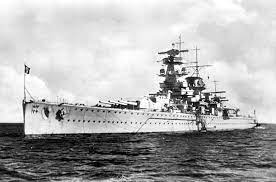
The game map spans from the South of Argentina to Senegal. My forces are spread out across the South Atlantic : twelve ships in total, including a modern Aircraft Carrier (the Ark Royal), a very old one (the Hermes), a battlecruiser (the Renown) and a mix of light and heavy cruisers, two of them French : the Foch and the Dupleix. Unlike in Computer Bismarck, there are no on-map aircrafts in Pursuit of the Graf Spee.
The game starts on the 1st of December. The location of the Graf Spee and its supply ship the Altmark is known : on a trade route off the coast of Africa, somewhere between the Hermes and the Ark Royal. Historically, the Graf Spee was reported to the British force by one of its victims, the SS Doric Star, on the 2nd of December, so it almost matches.
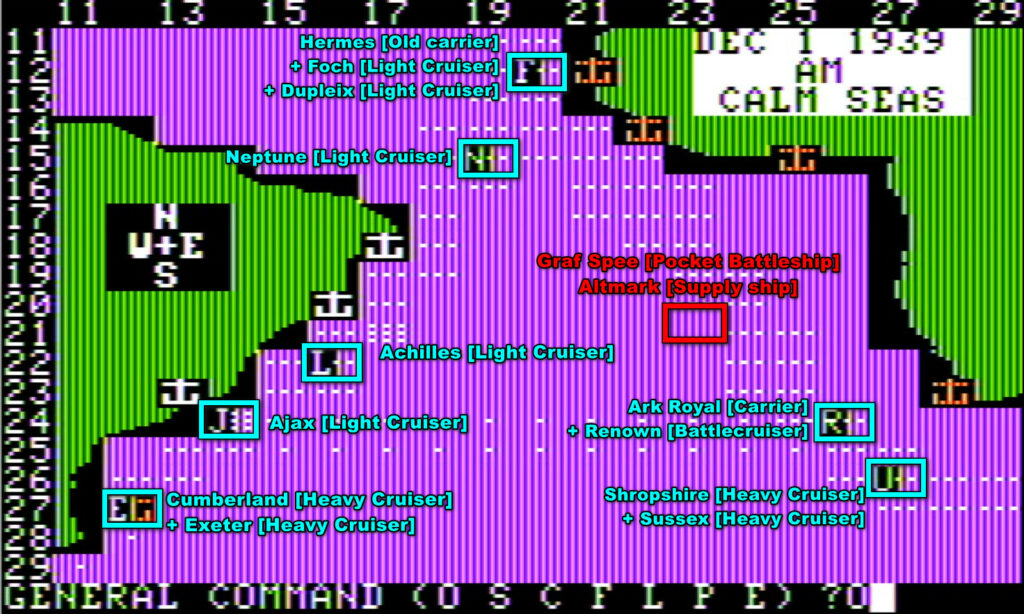
In theory, I should beeline at full speed to block the Northern and Southern parts of the shipping lanes, but fuel is an issue. Moving by day [“AM”] consumes 1 unit of fuel by turn, whereas moving by night [“PM”] consumes 3. If my ships run out of fuel, they will give victory points to the Germans every turn, though they will still be able to move by day. The allied ships have 25 maximum fuel, and they start the campaign with as little as 15 (the Ark Royal), so moving at nighttime without compelling reasons is supporting the German team !
Hence, my strategy for now is the following :
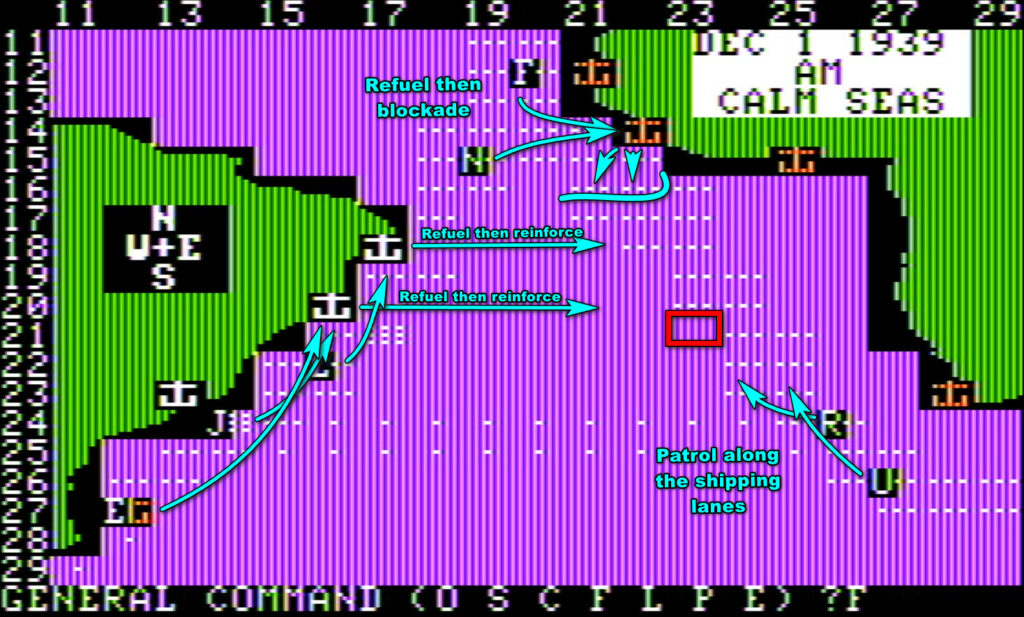
- The ships in the South-East will move by day only, slowly “scouting” while heading North-West -my hammer.
- In the North, the Hermes, the Neptune and the French ships will move as fast as possible to that port South of Senegal (Lagos ? Abidjan ?), then blockade the North of the shipping lane – my anvil.
- All the ships in South America will refuel in Brazil, before crossing for support.
What happens if the Graf Spee moves away from the shipping lanes ? Well, it won’t sink any merchant ship, but it will escape and I will have to hope for a chance sighting. But luckily, if I can say so, I am informed that several merchant ships are sunk on the night of the 1st of December and then on the morning of the 2nd, so the Graf Spee is behaving as predicted.

The weather gets much worse the second of December, which ruins my chance to find the Graf Spee… but suddenly :

The Graf Spee meets the pride of my fleet : my carrier and my only battlecruiser. Carriers can’t send their planes in stormy weather, so this battle is going to be a duel between the Renown and the Graf Spee. And that’s a battle I am happy to accept as the numbers are in my favour.

The Graf Spee has two turrets (one at the bow, one at the stern) with three 11 inch guns in each. The Renown has two turrets in the front and one in the back, with two 15 inch guns in each, so my guns are more powerful, and if I am “in pursuit” I have more guns too. The Graf Spee also has secondary guns (4 on port, 4 on starboard), but at 5.9 inches they are too small to threaten the Renown, except at extremely close range (8 000 yards). I am not going to ever come that close, especially since the Graf Spee has torpedoes and the Renown does not.
The Renown also has twice the belt armour, almost three times the turret armour and a better deck armour. Finally, it is faster so the Graf Spee can’t escape either. The Pursuit of the Graf Spee is going to end right here right now !
But things don’t go as expected. Due to the stormy weather, the battle starts at very close range – ten thousand yards – and at that range my armour does not protect against the Graf Spee‘s primary weapons.

The battle is extremely short, 3 rounds. Here are the two last rounds :
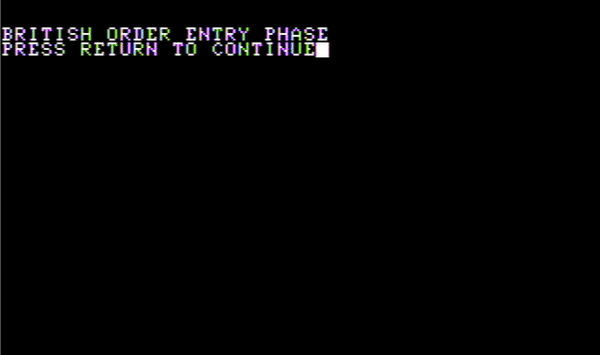
After a first round where both ships are ranging their guns, the Renown got hit twice, the Graf Spee not at all. That second hit crippled the Renown‘s engines, suddenly moving at 3 knots. This allows the Graf Spee to be at more than 12 000 yards from the Renown after movement resolution – more than the visibility distance given the weather – and the Graf Spee escapes immediately.
Oh well, at least I know where she is !
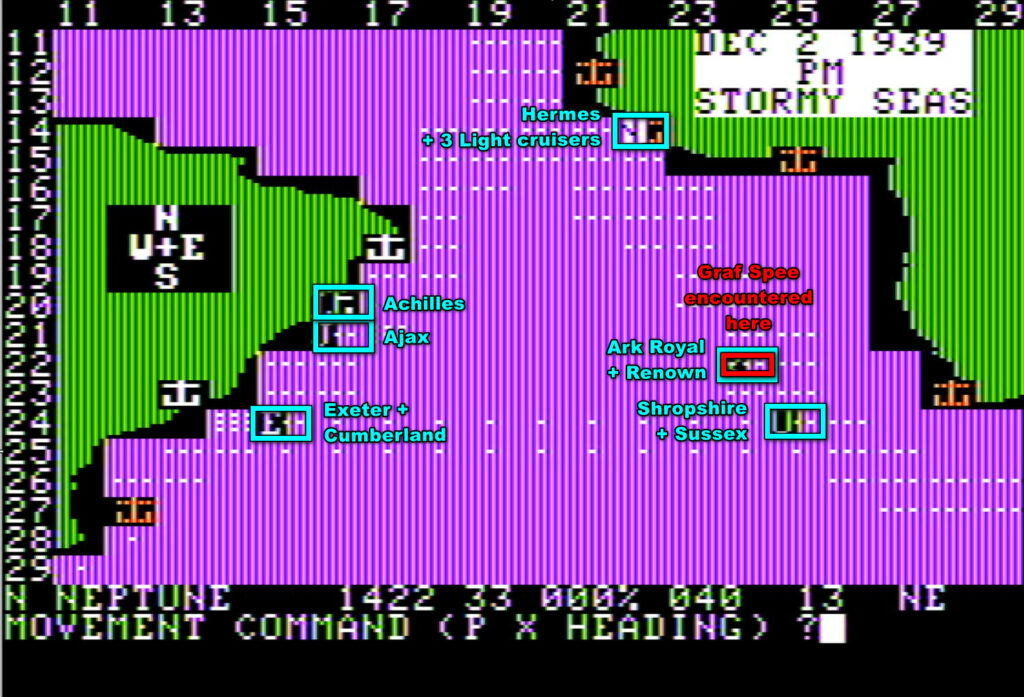
After this encounter, all my ships receive new orders.
- The fully refueled Neptune, Hermes, Foch and Dupleix are ordered to come South at double-time,
- The same order is given to the Achilles. The Ajax is allowed to spend one turn refueling,
- No time for the Exeter and the Cumberland to refuel, they will move by day and stop [“Patrol”] during the night,
- As for the Ark Royal and limping Renown, I don’t want to leave them on their own, so I merge them with the Sussex and the Shropshire,
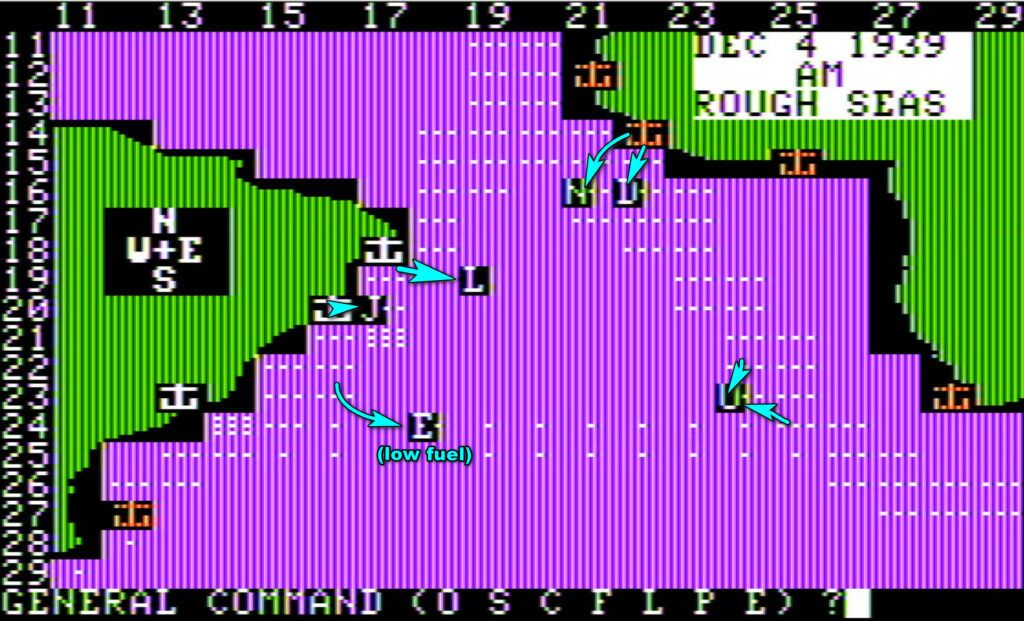
After a whole day of research on the 3rd of December, the Graf Spee eludes me. I decide to send the Renown for repair, escorted by the Ark Royal and the Shropshire. The Sussex will carry on the research.
And of course, who do I meet as I head toward a port ?

With the sea “rough” but not “stormy”, the Ark Royal sends bombers, without effect.

The battle starts at 17 000 yards. At this range, the Renown is almost immune to the guns of the Graf Spee, except for the deck – it does not stop the Germans from trying though.

The Graf Spee is quickly distancing herself from the crippled Renown so the Renown has only two turns to make a difference, after which the Graf Spee will be out of sight (20 000 yards). One turn is needed to range the guns, but luck turns the second turn :

The rear turret of the Graf Spee is destroyed ! The Graf Spee loses half its primary firepower, and well, in a game about being pursued, losing the rear turret is not good news.
The Renown is now out of the picture for this battle, but brave little Shropshire is still catching up with the Graf Spee. Go, little cruiser, go !
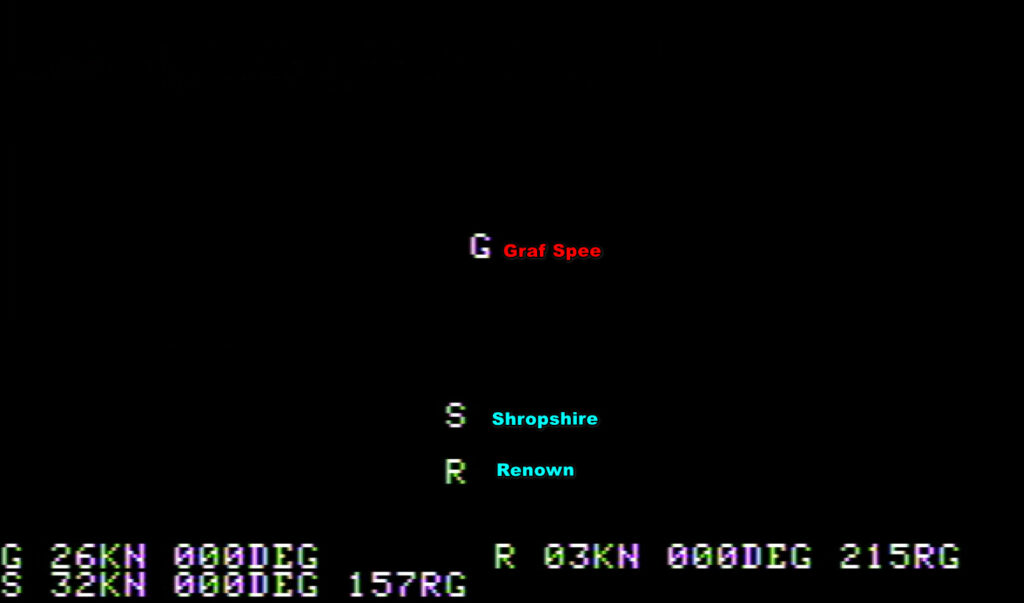
The Graf Spee opens fire with its secondaries on the Shropshire, but the latter has some armour (2 to 4 depending on where) so she should be safe fro…

So long, Shropshire. I could never pronounce your name anyway.
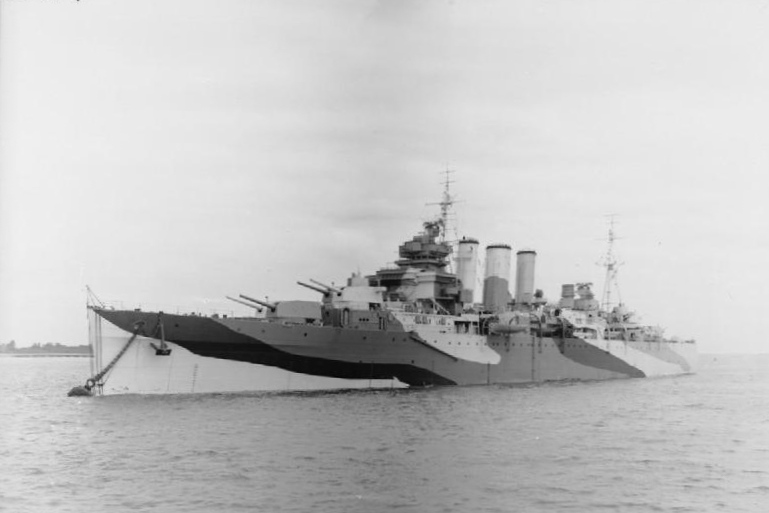
The Graf Spee disappears again ; with few ships in the area and the weather turning to storm again there is little I can do. The Sussex is searching just in case, while the Renown and the Ark Royal carry on their – slow – return to a port.
The 5th of December passes eventlessly. I receive whiny reports of more lost merchant ships, so at least I am confident the Graf Spee is somewhere on a shipping lane, most probably on the South-Eastern corner.
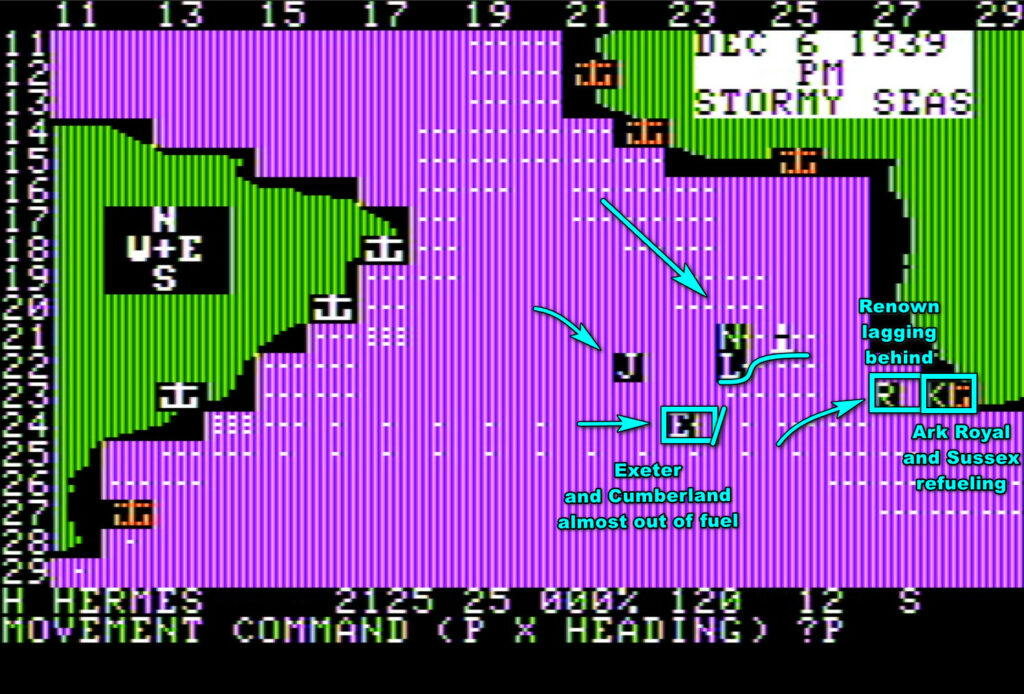
Two more days pass. The weather does not abate, and still no Graf Spee, nor news about merchant ships. It looks like the Graf Spee escaped. I am sending most of my ships to refuel, the Exeter and the Cumberland costing me a few VPs as they reached 0 fuel.
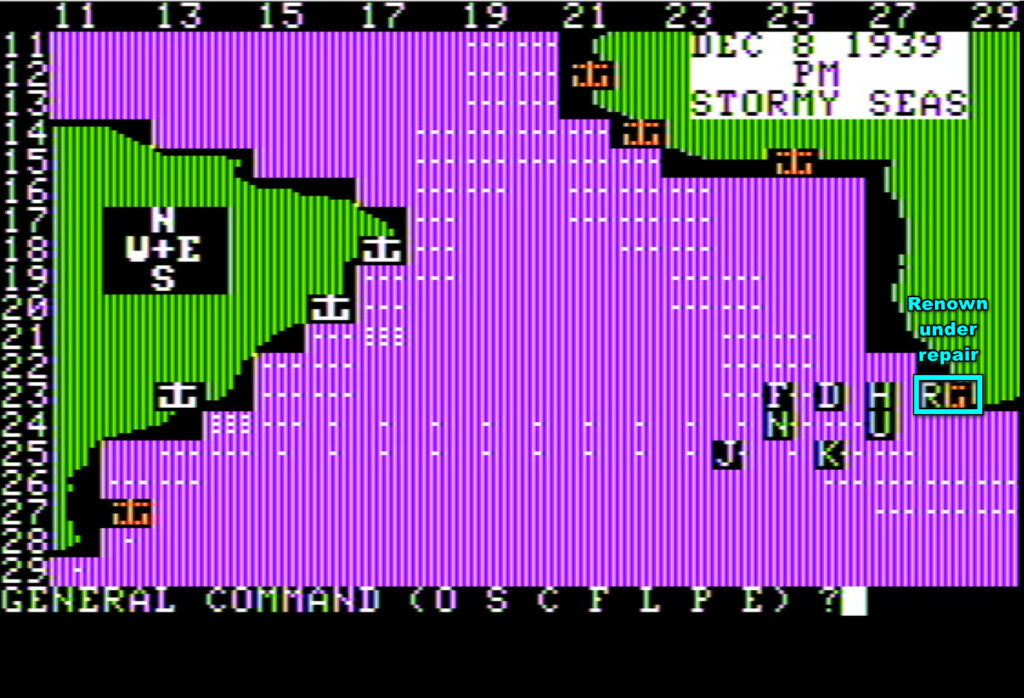
I also catch a German merchant ship, giving some intel to the Germans about my whereabouts :

Four more days and nothing, except some more lost allied merchant ships. It means the Graf Spee is on a shipping lane, but honestly it could be anywhere on the right half of the map – she may have passed my curtain of cruisers during the storm. I maintain a screen of ships in the vain hope that the Graf Spee is somewhere in the bottom right corner.
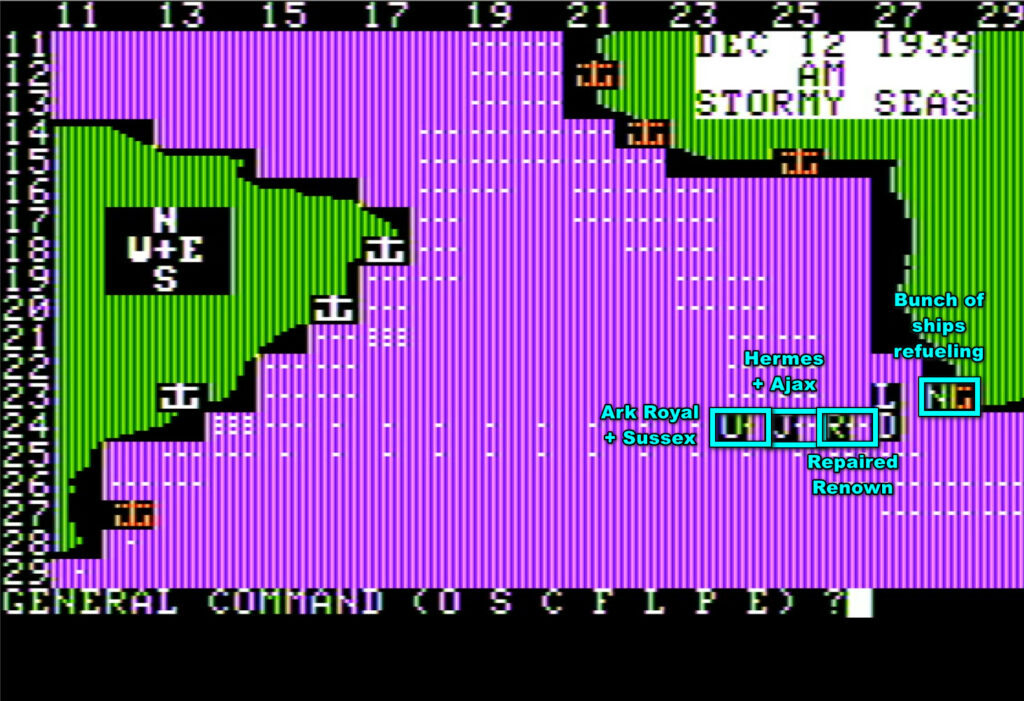
And suddenly :

Found her again !
With horrible weather, the Sussex is on its own and the battle starts at very short range – 7 500 yards. The Graf Spee immediately turns on its port to bring its front guns and secondaries into action. The Sussex can only use four smallish (8 inches) front guns, and one torpedo salvo. My objective is to damage the Graf Spee enough to slow it down to 20 knots or less, at which point she will not be able to move during night turns and I will easily catch up with her.
The Sussex passes along the Graf Spee. The Sussex launches torpedoes, but they miss. On the other hand, the guns do some damage, but not enough. The Sussex escapes with one rear turret destroyed.

The Sussex tries to shadow the Graf Spee, without success.
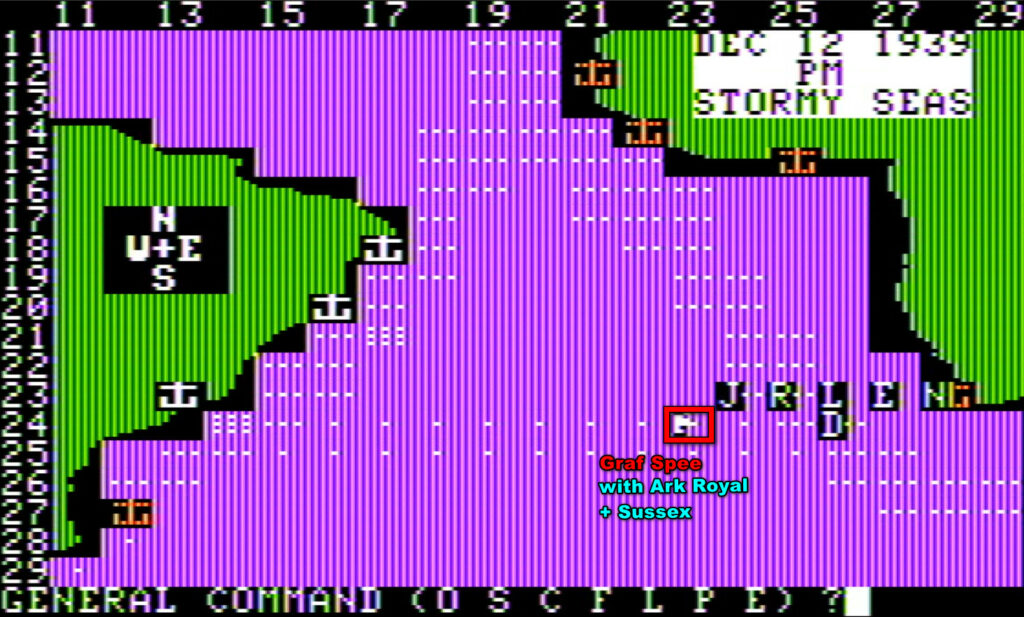
Well, at least it is not too far from the rest of my fleet, which has fully repaired and refuelled. The fleet deploys in a way allowing it to cover both “lines” of the East-West shipping lane :

And the Renown meets its nemesis again !

This time, the weather is calm, and the Hermes torpedo bombers manage to land some hits :

The battle between the Renown and the Graf Spee starts. The Graf Spee is limping at only 11 knots !
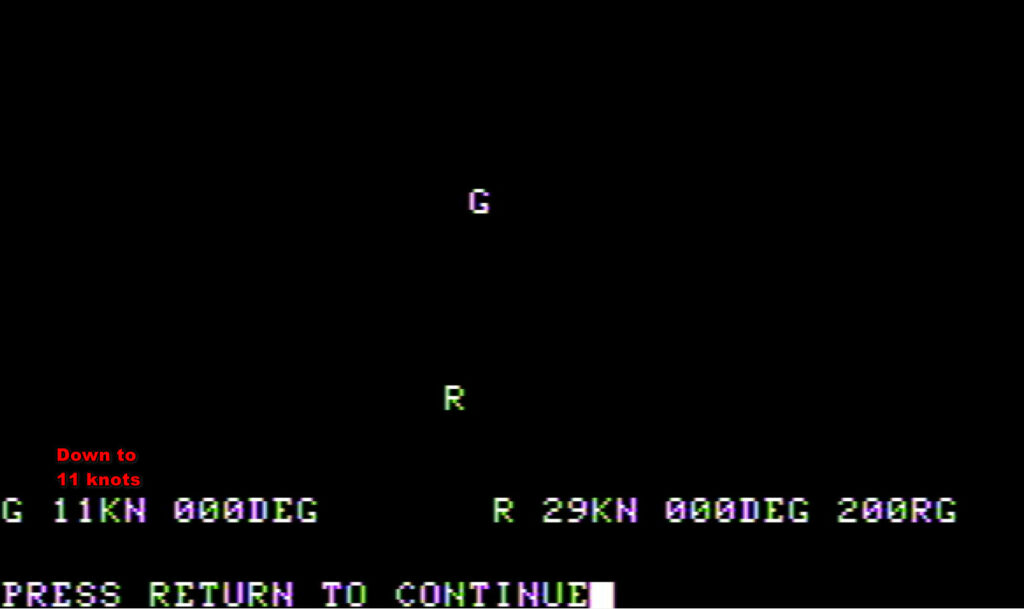
This is looking bad for the Graf Spee. With such a difference in speed, I can make sure I stay at the perfect distance where the Graf Spee’s guns are unlikely to penetrate my armour. I make the mistake of preferring to turn slowly not to throw off my aim, while the Graf Spee turns suddenly :

The Graf Spee gets a lucky hit, destroying one of my front turrets :

That will be her last feat. I manage to keep my distance, using only my rear turret, and finally :


At the end of the campaign, the game does something original, and offers you to check what was the journey of the Graf Spee and the Altmark :
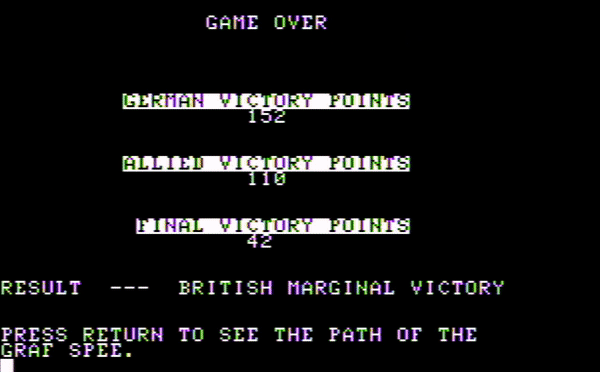
I have to admit, for a long time I thought the Graf Spee would escape – she certainly did better than the Bismarck.
Review and Rating

Pursuit of the Graf Spee by Joel Billings, and published by SSI, USA
First release : Apple II in March 1982
Tested on : Apple II emulator
Total Hours Tested : 3 hours
Average duration of a battle : 1 hour
Complexity : Average (2/5)
Would recommend to a modern player : No
Would recommend to a designer : No
Final Rating: Obsolete
For anyone looking for a follow-up to Computer Bismarck, the story of the Graf Spee is perfect : the stories are comparable, but not the same: the Graf Spee is weaker than the Bismarck, but it is facing less powerful ships. It has no cruiser to escort her, but also no blockade to run through. In 1981, Joel Billings – a naval miniature fan – thought it would be an easy and interesting project to take Computer Bismarck‘s code and port it to the Graf Spee. It was also something Billings felt he could do himself : while he had developed none of SSI’s previous games personally, he knew some BASIC from college where he had programmed a simple two-players tank game, and had even helped John Lyon on art integration and debugging for Computer Bismarck. As for the scenario, Billings told me he took inspiration from an expansion for the Bismarck board game published in July 1979 in The General, Avalon Hill’s magazine, though he does not remember to which extent. Checking The General, some similarities are obvious.
Billings started to work on Pursuit of the Graf Spee as a side summer project in 1981, but by fall the game was not finished and he could not spare much time for it anymore, so the production almost stopped. Eventually, Billings took a week of “vacation” in January 1982 to complete his project. As he told me : “Each night I went to bed an hour later, so by the end of the week I was staying up till 5 in the morning. I found what many programmers find, that the quiet of the night is a great time to program.” And the game got finished. With the decisive help of Paul Murray, Joel Billings even added a tactical layer of his design, thus fixing one of the common complaints reviewers had about Computer Bismarck. Always the wargamer, Billings also added a way to plug battle results obtained in a more custom way :

Pursuit of the Graf Spee was marketed and sold as a sister product to Computer Bismarck – more specifically Computer Bismarck was the “older brother” in some ads blurb. It had roughly the same content (manual, reference card doubling as a map ; only the grease pencils disappeared as they were not necessary anymore with the better UI of Pursuit of the Graf Spee) and it was sold at the same price : $59.99.
A. Immersion
Pursuit of the Graf Spee is immersive, but not as immersive as Computer Bismarck. The ruleset has been simplified significantly (no planes, no fog, alternate day turn and night turn), some new rules feel artificial (the one on losing VP when fuel runs out), and there is none of the chrome that Computer Bismarck had like ships breaking radio silence or the Allied receiving reinforcements over time.
The addition of tactical battles compensates those changes – battle outcomes always felt unrealistic in Computer Bismarck. Pursuit of the Graf Spee‘s battles have their issues – in particular ships can change their speed from 0 to maximum and do 180° in 3 minutes (one turn), but whatever the particulars their outcomes feel realistic.
Rating: Poor
B. UI , Clarity of rules and outcomes
Computer Bismarck‘s UI was a wreck. Pursuit of the Graf Spee is miles above its older brother. Computer Bismarck had 13 “general commands”, which then branched into 8 plane commands and 8 ship commands, and then you had to input the directions for more than 20 units, some disappearing from the UI as you move them.
On the strategic map, Pursuit of the Graf Spee has 8 commands in total, plus the directions – in practice you can play the full game only using the “Order” command” (upon which the computer cycles through your units asking you what you want to do with them).

The tactical battles are also easy to understand, except when there are a lot of ships close to the Graf Spee, and if this happens God help you. There is a command to check the coordinates, but my brain turned to mush when I tried to elaborate a strategy based on this :

Rating: Acceptable
C. Systems
I believe Pursuit of the Graf Spee is the first game with two fully developed gameplay layers: strategic and tactical. Earlier games either had a strategic layer, with battle automatically or almost automatically solved, or a couple “strategic” decisions feeding a tactical layer.
The strategic layer can be immediately compared to Computer Bismarck, but there are some key differences, explained by the different scales of the games :
- Computer Bismarck happens over 5 days in the seas between France and Iceland, so a small part of the Northern Atlantic, and most of the North Sea, one turn represents 4 hours.
- Pursuit of the Graf Spee happens over 25 days in an area covering all of the South Atlantic, one turn represents 12 hours.
This change of scale explains the change of rules. There are no planes on the strategic map, ships need to be refuelled regularly, speed is between 1 tile by turn and 1 tile every 2 turns, and critically the rules about detecting the Graf Spee are totally different.
Detection of the Bismarck was all about beating a “weather value” between 1 and 9, with 100% chance of detecting her if the value is beaten, and 0% otherwise. For the Graf Spee, detection is chance-based, with odds depending on the weather and the number of ships on the tile :

Such odds are certainly realistic given the size of the Atlantic, but they do not work in the context of this game.
To explain why this design fails, I am going to use a concept of modern French submarine doctrine called dilution. The idea of dilution is that the longer time has passed since a submarine has been detected by the enemy, the more it is dilué (diluted) in the ocean : its position from the point of view of the enemy becomes more and more random. This could apply to World War surface raiders: the more time has passed, the more they are diluted.
In Computer Bismarck, as an allied player, you can control the dilution of the Bismarck. You have a general idea of where the Bismarck might be, and every turn due to weather pattern, the quality of your blockade and your exploration, the dilution either increases or decreases a bit. Even when the weather is bad you can limit how much the Bismarck can dilute, so when the weather gets better you can try to push back the dilution down to 0 again. This is possible due to the geography of the map, due to the number of ships you have, and because the rules of detection are deterministic so you can exclude tiles easily. Even if the Bismarck passes your blockade and becomes “diluted”, you know its targets (your convoys), so while you don’t know where it is you know where it is heading to.
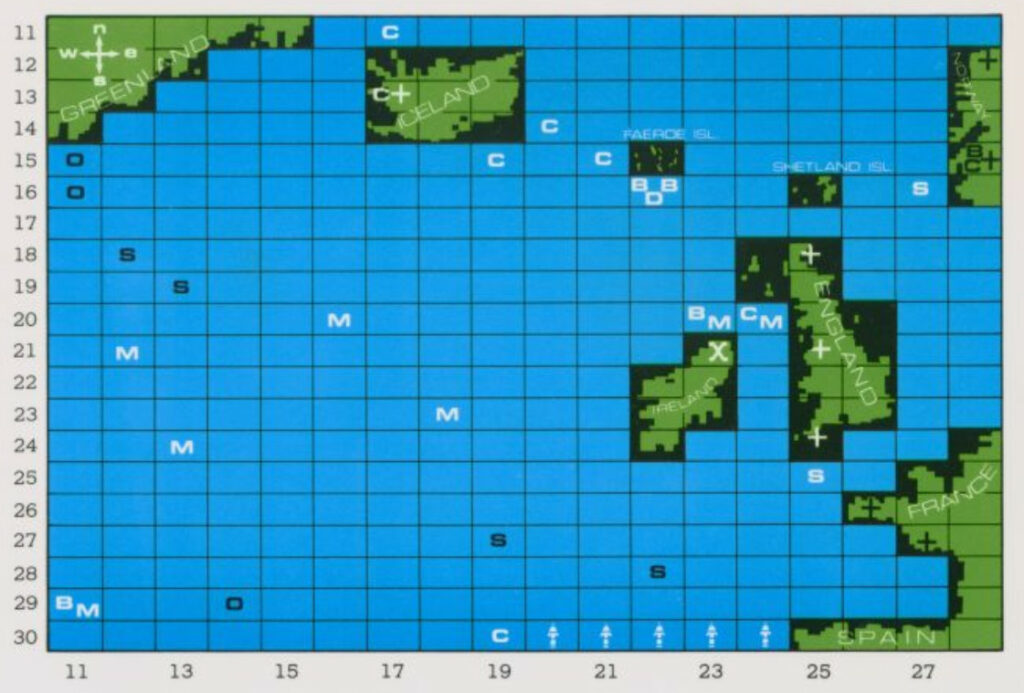
On the other hand, the Graf Spee dilutes too easily. Most of the campaign happens far away from the coastline, so when detected the Graf Spee has 8 tiles to escape, which you must cover with only 12 ships (some of them statistically out of fuel). Worse, you can never be sure that the Graf Spee is not at the same location as one of your ships, except of course if you have clear weather and are willing to allocate 8 equivalent-ships to a specific tile. Worst, the Graf Spee does not need to be anywhere specific to sink merchant ships – those shipping lanes tiles are all over the place. What this means is that if you spot the Graf Spee and fail to shadow it can be in 9 different tiles the following turn, in 25 tiles the turn after that ; and there is little you can do to prevent that. Said otherwise, finding the Graf Spee is about luck, not skill ; you have to hope to be on the same tile as the Graf Spee and have a good roll on the Search table, with only random events stating that “a merchant ship has seen the Graf Spee“ as a general indication about where you should be… I found the Graf Spee in my two campaigns of this game, both times I considered myself incredibly lucky.
On a more positive note, the new tactical module is the cream of the crop compared to other games of its generation.
- Primary, secondaries AND torpedoes with limited angle of fire (240°),
- Penetration table depending on calibre and distance,
- Damage to specific parts of the battleship like turret and engine but also rudder or fire control system,
- Initial combat distance depending on visibility,
As I stated, the one ugly part is that ships have infinite turning rate and acceleration. The only limit to turning rate is that if a ship turns by more than 30° in a turn it needs to spend one turn “ranging” its guns again, which in practice means firing at 30% of the normal accuracy.
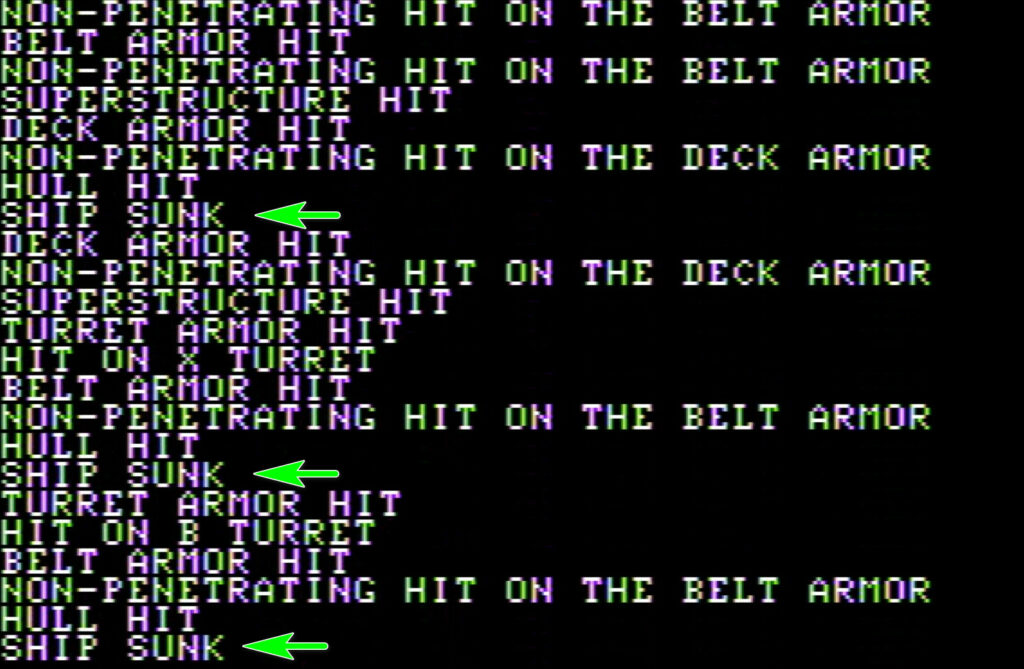
Nonetheless, it works well, and players must decide whether they want to close or increase the distance as fast as possible or angle their ships in a way that allows maximum firepower. Even better, it also has major consequences on the strategic layer of the game. For instance, the allied heavy cruisers cannot seriously hope to harm the Graf Spee below 16 000 yards, and the light cruisers will have to trust their torpedoes at 8 000 yards or less. But in good weather, battles start at 24 000 or more yards (day or night is sadly irrelevant), so cruisers are likely to be sunk before being in range if they try to catch the Graf Spee. Consequently, if the battlecruiser is not around for support, the cruisers have only two options : zerg rush, or shadow the Graf Spee on the strategic map and wait for the visibility to decrease.

Rating: Very poor for the strategic layer, excellent for the tactical layer
D. Scenario design & Balancing
There are two scenarios in Pursuit of the Graf Spee: the one I played – starting the 1st of December, and the one starting the 13th of December with the historical Battle of the River Plate, starting with the battle between the Ajax, the Achilles, the Exeter and the Graf Spee. I checked briefly and the best strategy for the allies is to break off combat immediately, try to shadow the Graf Spee (80% of chance in the first turn) and then hope for the best – dilution or not.
I already discussed the problems caused by the scenario parameters (only 12 allied ships, open sea, no specific targets) as they interact with the ruleset, I would just add that I wonder whether the AI is weak or if it is on purpose trying to be somehow “reachable” by staying on the shipping lanes.
Rating: Very poor, due to its interaction with the ruleset.
E. Did I make interesting decisions ?
Yes, sometimes. On the strategic map these were not about the chase, they were mostly about when to send ships to repair or to refuel. As I explained, I don’t feel a player can take many strategic decisions in the pursuit itself, except when betting on the AI weakness as I did ; if you don’t find the Graf Spee in the turn following her being detected you can assume she diluted.
On the tactical aspect, you will have to decide when to fight and when to run, and outside of the AAR I had one epic and “tactical” battle between the Graf Spee and my fleet composed of the Foch, the Neptune and the Cumberland – I could not employ the Renown as it had been sunk by a lucky magazine hit in an earlier battle.
F. Final rating
A difficult choice. I had fun, but I feel that was mostly because I was lucky and/or the AI was weak, and I could have very well spent one hour searching the ocean fruitlessly. The battle system is extremely solid, but you won’t enjoy it if you don’t find the Graf Spee, and even if you find it, if you have only one cruiser in your fleet there will not be much of a battle anyway. I conclude on well-designed for the tactical part but still mostly obsolete [for the strategic part, bringing down the rest of the game with it]. I believe Computer Bismarck is the better game, despite its atrocious UI. Paradoxically, I am more likely to replay Pursuit of the Graf Spee than Computer Bismarck, but this is only because a campaign of Computer Bismarck can last up to 5 hours, while Pursuit, as frustrating as it sometimes is, can be completed in one hour.
Contemporary Reviews
Computer Gaming World reviewed the game as early as July 1982. In his review, William Edmunds explains the strategic and tactical challenges faced by the Allied player : “Your ships all have more speed and can overtake the Spee, but except for the Renown, your guns are smaller […]. If you start your pursuit from a long range, your ships, one by one, will succumb to the Spee’s larger guns.” He concludes by saying it is a “good intermediate level war game”. It combines a strategic game, its anguish of unsuccessful searching with tactical battle which can produce the thrill of battle when you are finally closing for the kill.”
Bob Proctor, frequently mentioned here, did not get to cover the wargame in Computer Gaming World, but he gets to review it exactly at the same time in Softline. Comparing it to Computer Bismarck, he calls it “faster, simpler and just as much fun to play”. A benchmark echoed by Brian Murphy in Creative Computing (July 1983), who states Pursuit of the Graf Spee has “more excitement, more action and greater playability” [than Computer Bismarck], though it is also simplified and less realistic. Murphy also states the game heavily favours the German player : “almost any strategy will work for him”.
In France, the game is first reviewed by the wargame specialist Casus Belli (February 1983). Frédéric Armand claims the tactical part is the most interesting bit and yet has significant weaknesses, in particular, Armand is frustrated by the Graf Spee always starting battles turned away from the allied ships, and avoiding combat – a criticism that seems a bit unfair to me. Armand concludes by saying that Pursuit of the Graf Spee is agreeable, nothing more, and already “a bit outdated“. Pros: “colorful graphics” and “manual is translated in French” !
It is still a better review than the generalist Jeux & Strategie in August 1983, which gave the game one star, the complaints being on how difficult the Graf Spee is to find. Surprisingly, the video game generalist Tilt manages to almost reconcile both points of view in its March 1984 overview of existing wargames. The game is described as “a good quality wargame despite limited [graphics]”, with the further comment that the game felt “very close to reality“, earning the game a rating of … 1 star out of 6 in interest and 3 out of 6 in realism. Yes, it does not match the review at all, and is a testament to the amateurishness of Tilt in its early years.
In any case, good (American) reviews don’t necessarily make good sales. Even though it was consistently described as better than Computer Bismarck, Pursuit of the Graf Spee only sold 2 082 copies, disappointing compared to the 7 700 copies of a Shattered Alliance or the more than 8 000 copies of Computer Bismarck. In Spring 1986, Pursuit of the Graf Spee is pulled from SSI’s catalog – but the two-years older Computer Bismarck is still there.